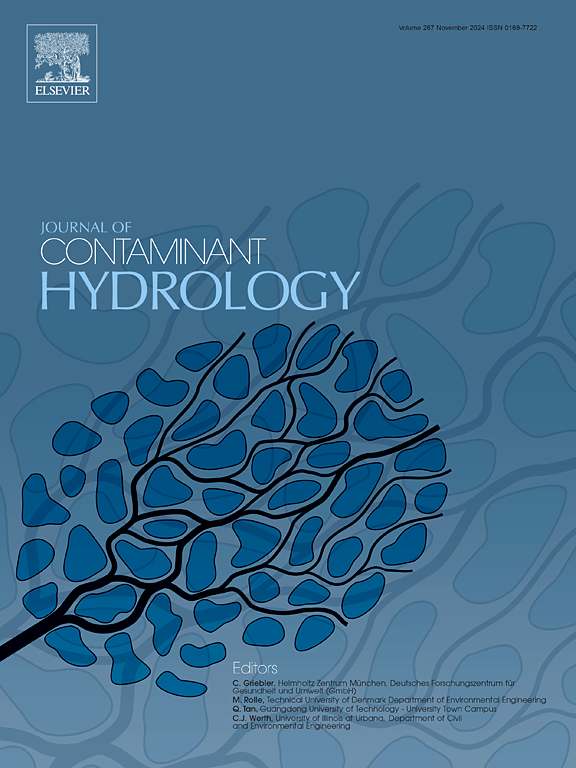Photocatalytic remediation of river ganga waters using TiO₂ nanoparticles: Linking structural and magnetic properties to aquatic water quality improvement
IF 4.4
3区 环境科学与生态学
Q2 ENVIRONMENTAL SCIENCES
引用次数: 0
Abstract
Freshwater contamination from industrial, agricultural, and domestic activities remains a serious environmental challenge, particularly in the Ganga River basin of India. In this work, the photocatalytic activity of TiO₂ nanoparticles was evaluated for treating real wastewater samples collected from three polluted sources. Photocatalysis led to marked improvements in water quality, including substantial reductions in COD and BOD, stabilization of pH to near-neutral values, and partial reduction of dissolved solids. Material characterizations confirmed the durability of TiO₂ during treatment. XRD verified anatase phase stability, SEM–EDS revealed unchanged morphology with decreased oxygen vacancies, and magnetization measurements showed reduced values consistent with vacancy annihilation and Ti3+ re-oxidation. These changes correlate with enhanced oxidative processes responsible for pollutant degradation. Overall, TiO₂ demonstrated robust performance, reusability, and structural stability, underscoring its promise as a sustainable photocatalyst for decentralized water treatment in polluted riverine and industrial regions.
二氧化钛纳米颗粒光催化修复恒河水体:结构和磁性与水质改善的联系
来自工业、农业和家庭活动的淡水污染仍然是一个严重的环境挑战,特别是在印度的恒河流域。在这项工作中,评价了tio2纳米颗粒对三种污染源实际废水样品的光催化活性。光催化导致水质显著改善,包括COD和BOD大幅降低,pH稳定到接近中性值,溶解固体部分减少。材料表征证实了处理过程中tio2的耐久性。XRD验证了锐钛矿的相稳定性,SEM-EDS显示形貌不变,氧空位减少,磁化值减少,与空位湮灭和Ti3+再氧化一致。这些变化与负责污染物降解的氧化过程的增强有关。总的来说,二氧化钛表现出强大的性能、可重复使用性和结构稳定性,强调了它作为一种可持续光催化剂的前景,用于污染河流和工业区的分散水处理。
本文章由计算机程序翻译,如有差异,请以英文原文为准。
求助全文
约1分钟内获得全文
求助全文
来源期刊

Journal of contaminant hydrology
环境科学-地球科学综合
CiteScore
6.80
自引率
2.80%
发文量
129
审稿时长
68 days
期刊介绍:
The Journal of Contaminant Hydrology is an international journal publishing scientific articles pertaining to the contamination of subsurface water resources. Emphasis is placed on investigations of the physical, chemical, and biological processes influencing the behavior and fate of organic and inorganic contaminants in the unsaturated (vadose) and saturated (groundwater) zones, as well as at groundwater-surface water interfaces. The ecological impacts of contaminants transported both from and to aquifers are of interest. Articles on contamination of surface water only, without a link to groundwater, are out of the scope. Broad latitude is allowed in identifying contaminants of interest, and include legacy and emerging pollutants, nutrients, nanoparticles, pathogenic microorganisms (e.g., bacteria, viruses, protozoa), microplastics, and various constituents associated with energy production (e.g., methane, carbon dioxide, hydrogen sulfide).
The journal''s scope embraces a wide range of topics including: experimental investigations of contaminant sorption, diffusion, transformation, volatilization and transport in the surface and subsurface; characterization of soil and aquifer properties only as they influence contaminant behavior; development and testing of mathematical models of contaminant behaviour; innovative techniques for restoration of contaminated sites; development of new tools or techniques for monitoring the extent of soil and groundwater contamination; transformation of contaminants in the hyporheic zone; effects of contaminants traversing the hyporheic zone on surface water and groundwater ecosystems; subsurface carbon sequestration and/or turnover; and migration of fluids associated with energy production into groundwater.
 求助内容:
求助内容: 应助结果提醒方式:
应助结果提醒方式:


